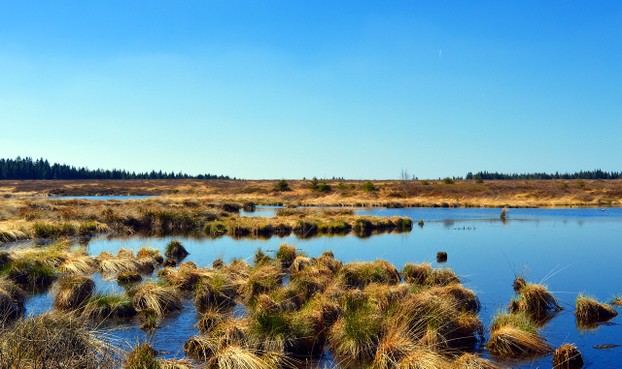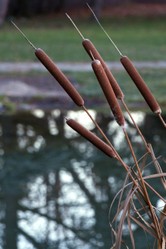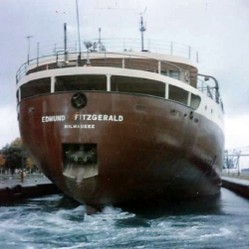The Solway Firth [estuary] lies near the western border between England and Scotland, but during the Middle Ages the border was disputed and some lands on either side were called "The Debatable Lands." Included in this borderland was Solway Moss, on the north of the Solway Firth [estuary] in Cumbria, England.Its inhabitants were small farmers who eked out a living in the windswept, damp land and who used the moss, a typical raised bog, as a source of summer pasture and peat for fuel. I must explain that in Northern English usage a moss is a bog.For example, a bog near where I live is called Black Moss.
Solway Moss has a grim history, for it was the site of a vicious battle in 1542 in which Henry the Eighth's forces won a victory over the seriously disorganised Scottish army. As usual, the aggressor was England's corpulent tyrant, who had invaded South West Scotland to coerce the Scottish king into accepting a reformation of the church on Henry's lines, which Scotland's Catholic king did not want to do, but the badly led Scottish defenders were driven away in disorder. Many Scots fleeing across the Moss were drowned in the hidden mires.
The bog had been growing since the end of the Ice Age twelve thousand years ago, but it had been shaped by human activity. The grazing of cattle had no effect on its structure, but peat digging did.The local people dug peat for fuel, and did so on the edges of the bog. They carted away the peat blocks, casually throwing the peat crumbs onto the ground, and these were trampled and compacted by footfall. This process went on for millenia, and slowly, without anyone noticing a thick wall of compacted peat began to develop around the bog. This growth of an inadvertent damn went on for untold time. But to make matters worse, as the damn grew so did the bog. Rather than spread out as it would do naturally it grew upwards.
Bog growth is caused by the fact that sphagnum moss takes carbon and oxygen from the air, but does not decay properly, turning into peat, which traps CO2. Deposits of this semi-decayed plant resource accumulate over time, making bogs quite deep. In fact raised bogs can be domed in the middle. By 1771 the firm wall of Solway Moss was entrapping a bog that was fifty feet higher than the surrounding land, a vast reserve of soggy peat waiting to burst.
Local people may have been aware of the danger, as bogs had slid before, though many would not have known of the large bog slide of Chat Moss near Manchester in South Lancashire in the seventeeth century, but they lived in hope and fear, trapped by poverty and unable to migrate to somewhere safer.Then in November 1771 came the deluge, a sustained period of heavy rain saturated the bog and soaked the damn, fatally weakening it. On November the Sixteenth the weakened damn gave way and millions of tons of peat began to slide slowly and inexorably towards the nearby River Esk, one of the rivers that flow into the Solway Firth





 Women of the Gospelson 10/11/2025
Women of the Gospelson 10/11/2025
 Religious Gardenson 08/25/2025
Religious Gardenson 08/25/2025
 Doctor of the Church: John Henry Newmanon 08/03/2025
Doctor of the Church: John Henry Newmanon 08/03/2025
 Restoring the Palm Houseon 07/16/2025
Restoring the Palm Houseon 07/16/2025


Comments
He was an active writer, but what his most famous book was I know not.
Thank you for your comment below, on Jan. 23, 2020, in answer to my previous observation and question.
The library system does not have the Bellamy book even as some online sources drew me to some interesting bog-general, Solway Moss-specific information.
English Wikipedia gives David Bellamy vital dates of Jan. 18, 1933-Dec. 11, 2019.
Is his Ireland book his famousest publication?
Nice to hear from you again, Derdriu.
A good book for studying bogs is David Bellamy's Ireland.
Solway Moss was grazed carefully, but not overgrazed, so it never suffered ecological degradation.
frankbeswick, Thank you for the practical information.
How can there be no product lines associated with your timely article? Do you know of book, journal or online sources that you'd recommend for raised bogs and Solway Moss?
It's interesting that "The bog had been growing since the end of the Ice Age twelve thousand years ago, but it had been shaped by human activity. The grazing of cattle had no effect on its structure." Is it that the numbers never kept the bog from structuring as it should or just that grazing never would have impaired Solway Moss?
Chat Moss, north west of Manchester, is on very flat ground, but it slid in the seventeenth century because it was domed and and outward pressure forced the peat to expand. But this moss was taken over and claimed for agriculture, a land use that took away some of the expansionary pressures on the peat.
There are different kinds of bog, each with their own characteristic vegetation. Raised bog is a filled-in swamp/fen, which can be dome-shaped, and this tens to slide when on a slope. There is upland blanket bog and lowland, which tend to be less prone to sliding, though these kinds can slide. Raised bogs are made of decayed sphagnum moss and they contain much water, rendering them unstable.
In Ireland when I was walking on the slopes of the Glenfarne Plateau in County Leitrim I encountered a situation where swelling bog had produced not a slide, but the rising of a massive block of peat about six feet high and I don't know how long and wide The bog was filling up and as it was confined between stone walls had to swell upwards. It is situations like tis that make me disposed to mine some peat to keep the bogs stable.
Sphagnum moss can and should be harvested, as it makes a great antiseptic wound dressing, and was used for this purpose in World War One
I was unaware of bogs being able to move out and act as a landslide.
The cockle fishers could have been saved had they been on the beach, but they went out at night too far onto sandbanks where no wise person treads without very good cause and even then not alone.The tide there races in faster than a person can run. You are right about the role of the narrow channel between Britain and Ireland not far north of this region, for the currents through the narrows are strong and dangerous and then they meet a powerful flow surging out of the Solway.
Again the beauty of Wizzley for me is its educational value. It is like doing a world tour with experts. I love reading about all these features from around the world.
Frank and I live over 50 miles from the North West coast. It is exceptionally beautiful, but treacherous and dangerous land. A few years ago there was a major disaster when some illegal cockle fishers were stranded and killed on the beaches at Morecambe bay . Further along, a horn sounds to announce The Bore is due to sweep in down the estuary and people evacuate.
Beautiful and deadly. Part of the trouble is indeed the Irish sea which flows narrowly between England and Ireland.
The speed of flow depends on gravity. On a slope it can be fast indeed, but the problem at Solway Moss was that while the land sloped but gently, the bog was fifty feet higher than the surrounding land. The peat is also more viscous that mud, so it slid more slowly than a mudslide does.
An ammunition factory was erected on the site and worked for a few years, but generally land in that region is hard to farm. It is quite marginal, and many farmers have to work hard to keep their land from becoming waterlogged. The factory is now derelict. I would not buy land round there.